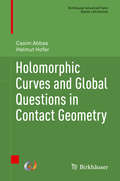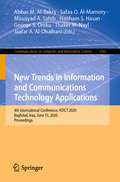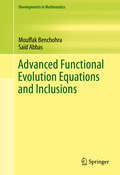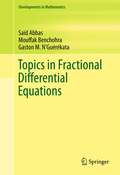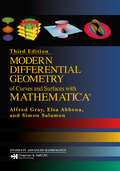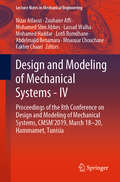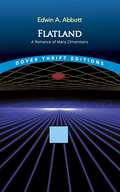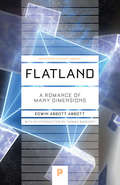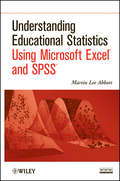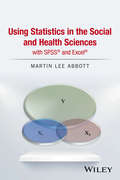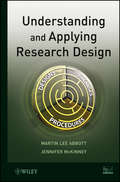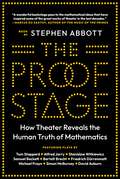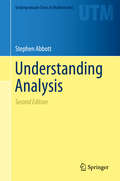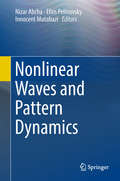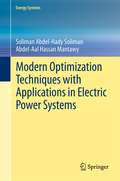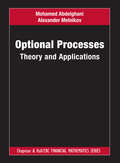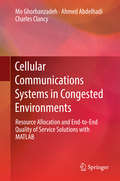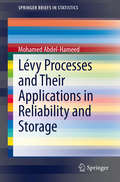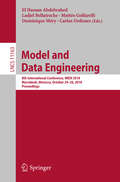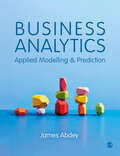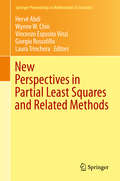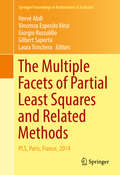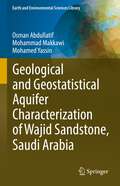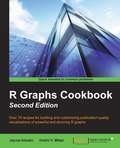- Table View
- List View
Holomorphic Curves and Global Questions in Contact Geometry (Birkhäuser Advanced Texts Basler Lehrbücher)
by Casim Abbas Helmut HoferThis book explains the foundations of holomorphic curve theory in contact geometry. By using a particular geometric problem as a starting point the authors guide the reader into the subject. As such it ideally serves as preparation and as entry point for a deeper study of the analysis underlying symplectic field theory.An introductory chapter sets the stage explaining some of the basic notions of contact geometry and the role of holomorphic curves in the field. The authors proceed to the heart of the material providing a detailed exposition about finite energy planes and periodic orbits (chapter 4) to disk filling methods and applications (chapter 9).The material is self-contained. It includes a number of technical appendices giving the geometric analysis foundations for the main results, so that one may easily follow the discussion. Graduate students as well as researchers who want to learn the basics of this fast developing theory will highly appreciate this accessible approach taken by the authors.
New Trends in Information and Communications Technology Applications: 4th International Conference, NTICT 2020, Baghdad, Iraq, June 15, 2020, Proceedings (Communications in Computer and Information Science #1183)
by Abbas M. Al-Bakry Safaa O. Al-Mamory Mouayad A. Sahib Haitham S. Hasan George S. Oreku Thaker M. Nayl Jaafar A. Al-DhaibaniThis book constitutes refereed proceedings of the 4th International Conference on New Trends in Information and Communications Technology Applications, NTICT 2020, held on June 15, 2020. The NTICT conference was planned to take place in Baghdad on March 11-12, 2019, but due to the COVID-19 pandemic the conference has been postponed on June 15, 2020 and moved to the virtual format.The 15 full papers and 3 short papers presented were thoroughly reviewed and selected from 90 qualified submissions. The volume presents the latest research results in such areas as network protocols, overlay and other logical network structures, wireless access networks, computer vision, machine learning, artificial Intelligence, data mining, control methods.
Advanced Functional Evolution Equations and Inclusions (Developments in Mathematics #39)
by Saïd Abbas Mouffak BenchohraThis book presents up-to-date results on abstract evolution equations and differential inclusions in infinite dimensional spaces. It covers equations with time delay and with impulses, and complements the existing literature in functional differential equations and inclusions. The exposition is devoted to both local and global mild solutions for some classes of functional differential evolution equations and inclusions, and other densely and non-densely defined functional differential equations and inclusions in separable Banach spaces or in Fréchet spaces. The tools used include classical fixed points theorems and the measure-of non-compactness, and each chapter concludes with a section devoted to notes and bibliographical remarks. This monograph is particularly useful for researchers and graduate students studying pure and applied mathematics, engineering, biology and all other applied sciences.
Topics in Fractional Differential Equations
by Saïd Abbas Mouffak Benchohra Gaston M. N'GuérékataTopics in Fractional Differential Equations is devoted to the existence and uniqueness of solutions for various classes of Darboux problems for hyperbolic differential equations or inclusions involving the Caputo fractional derivative. Fractional calculus generalizes the integrals and derivatives to non-integer orders. During the last decade, fractional calculus was found to play a fundamental role in the modeling of a considerable number of phenomena; in particular the modeling of memory-dependent and complex media such as porous media. It has emerged as an important tool for the study of dynamical systems where classical methods reveal strong limitations. Some equations present delays which may be finite, infinite, or state-dependent. Others are subject to an impulsive effect. The above problems are studied using the fixed point approach, the method of upper and lower solution, and the Kuratowski measure of noncompactness. This book is addressed to a wide audience of specialists such as mathematicians, engineers, biologists, and physicists.
Modern Differential Geometry of Curves and Surfaces with Mathematica (Textbooks in Mathematics)
by Elsa Abbena Simon Salamon Alfred Gray<p>Presenting theory while using Mathematica in a complementary way, Modern Differential Geometry of Curves and Surfaces with Mathematica, the third edition of Alfred Gray’s famous textbook, covers how to define and compute standard geometric functions using Mathematica for constructing new curves and surfaces from existing ones. Since Gray’s death, authors Abbena and Salamon have stepped in to bring the book up to date. While maintaining Gray's intuitive approach, they reorganized the material to provide a clearer division between the text and the Mathematica code and added a Mathematica notebook as an appendix to each chapter. They also address important new topics, such as quaternions. <p>The approach of this book is at times more computational than is usual for a book on the subject. For example, Brioshi’s formula for the Gaussian curvature in terms of the first fundamental form can be too complicated for use in hand calculations, but Mathematica handles it easily, either through computations or through graphing curvature. Another part of Mathematica that can be used effectively in differential geometry is its special function library, where nonstandard spaces of constant curvature can be defined in terms of elliptic functions and then plotted. Using the techniques described in this book, readers will understand concepts geometrically, plotting curves and surfaces on a monitor and then printing them. <p>Containing more than 300 illustrations, the book demonstrates how to use Mathematica to plot many interesting curves and surfaces. Including as many topics of the classical differential geometry and surfaces as possible, it highlights important theorems with many examples. It includes 300 miniprograms for computing and plotting various geometric objects, alleviating the drudgery of computing things such as the curvature and torsion of a curve in space.</p>
Design and Modeling of Mechanical Systems - IV: Proceedings of the 8th Conference on Design and Modeling of Mechanical Systems, CMSM'2019, March 18–20, Hammamet, Tunisia (Lecture Notes in Mechanical Engineering)
by Mohamed Slim Abbes Fakher Chaari Mohamed Haddar Lotfi Romdhane Abdelmajid Benamara Mnaouar Chouchane Nizar Aifaoui Zouhaier Affi Lassad WalhaThis book offers a collection of original peer-reviewed contributions presented at the 8th International Congress on Design and Modeling of Mechanical Systems (CMSM’2019), held in Hammamet, Tunisia, from the 18th to the 20th of March 2019. It reports on research, innovative industrial applications and case studies concerning mechanical systems and related to modeling and analysis of materials and structures, multiphysics methods, nonlinear dynamics, fluid structure interaction and vibroacoustics, design and manufacturing engineering. Continuing on the tradition of the previous editions, these proceedings offers a broad overview of the state-of-the art in the field and a useful resource for academic and industry specialists active in the field of design and modeling of mechanical systems. CMSM’2019 was jointly organized by two leading Tunisian research laboratories: the Mechanical Engineering Laboratory of the National Engineering School of Monastir, University of Monastir and the Mechanical, Modeling and Manufacturing Laboratory of the National Engineering School of Sfax, University of Sfax.
Flatland: A Romance of Many Dimensions (Dover Thrift Editions: Classic Novels)
by Edwin A. AbbottThis masterpiece of science (and mathematical) fiction is a delightfully unique and highly entertaining satire that has charmed readers for more than 100 years. The work of English clergyman, educator and Shakespearean scholar Edwin A. Abbott (1838-1926), it describes the journeys of A. Square, a mathematician and resident of the two-dimensional Flatland, where women-thin, straight lines-are the lowliest of shapes, and where men may have any number of sides, depending on their social status.Through strange occurrences that bring him into contact with a host of geometric forms, Square has adventures in Spaceland (three dimensions), Lineland (one dimension) and Pointland (no dimensions) and ultimately entertains thoughts of visiting a land of four dimensions—a revolutionary idea for which he is returned to his two-dimensional world. Charmingly illustrated by the author, Flatland is not only fascinating reading, it is still a first-rate fictional introduction to the concept of the multiple dimensions of space. "Instructive, entertaining, and stimulating to the imagination." — Mathematics Teacher.
Flatland: A Romance of Many Dimensions
by Edwin Abbott Abbott Thomas BanchoffIn 1884, Edwin Abbott Abbott wrote a mathematical adventure set in a two-dimensional plane world, populated by a hierarchical society of regular geometrical figures-who think and speak and have all too human emotions. Since then Flatland has fascinated generations of readers, becoming a perennial science-fiction favorite. By imagining the contact of beings from different dimensions, the author fully exploited the power of the analogy between the limitations of humans and those of his two-dimensional characters. A first-rate fictional guide to the concept of multiple dimensions of space, the book will also appeal to those who are interested in computer graphics. This field, which literally makes higher dimensions seeable, has aroused a new interest in visualization. We can now manipulate objects in four dimensions and observe their three-dimensional slices tumbling on the computer screen. But how do we interpret these images? In his introduction, Thomas Banchoff points out that there is no better way to begin exploring the problem of understanding higher-dimensional slicing phenomena than reading this classic novel of the Victorian era.
Understanding Educational Statistics Using Microsoft Excel® and Spss®
by Martin Lee AbbottUtilizing the latest software, this book presents the essential statistical procedures for drawing valuable results from data in the social sciences. Mobilizing interesting real-world examples from the field of education, Understanding Educational Statistics Using Microsoft Excel and SPSS supplies a seamless presentation that identifies valuable connections between statistical applications and research design. Class-tested to ensure an accessible presentation, the book combines clear, step-by-step explanations and the use of software packages that are accessible to both the novice and professional alike to present the fundamental statistical practices for organizing, understanding, and drawing conclusions from educational research data. The book begines with an introduction to descriptive and inferential statistics and then proceeds to acquaint readers with the various functions for working with quantitative data in the Microsoft Excel environment, such as spreadsheet navigation; sorting and filtering; and creating pivot tables. Subsequent chapters treat the procedures that are commonly-employed when working with data across various fields of social science research, including: Single-sample tests Repeated measure tests Independent t-tests One way ANOVA and factorial ANOVA Correlation Bivariate regression Chi square Multiple regression Individual chapters are devoted to specific procedures, each ending with a lab exercise that highlights the importance of that procedure by posing a research question, examining the question through its application in Excel and SPSS, and concluding with a brief research report that outlines key findings drawn from the results. Real-world examples and data from modern educational research are used throughout the book, and a related Web site features additional data sets, examples, and labs, allowing readers to reinforce their comprehension of the material. Bridging traditional statistical topics with the latest software and applications in the field of education, Understanding Educational Statistics Using Microsoft Excel and SPSS is an excellent book for courses on educational research methods and introductory statistics in the social sciences at the upper-undergraduate and graduate levels. It also serves as a valuable resource for researchers and practitioners in the fields of education, psychology, and the social sciences who require a statistical background to work with data in their everyday work.
Using Statistics in the Social and Health Sciences with SPSS and Excel
by Martin Lee AbbottProvides a step-by-step approach to statistical procedures to analyze data and conduct research, with detailed sections in each chapter explaining SPSS® and Excel® applications This book identifies connections between statistical applications and research design using cases, examples, and discussion of specific topics from the social and health sciences. Researched and class-tested to ensure an accessible presentation, the book combines clear, step-by-step explanations for both the novice and professional alike to understand the fundamental statistical practices for organizing, analyzing, and drawing conclusions from research data in their field. The book begins with an introduction to descriptive and inferential statistics and then acquaints readers with important features of statistical applications (SPSS and Excel) that support statistical analysis and decision making. Subsequent chapters treat the procedures commonly employed when working with data across various fields of social science research. Individual chapters are devoted to specific statistical procedures, each ending with lab application exercises that pose research questions, examine the questions through their application in SPSS and Excel, and conclude with a brief research report that outlines key findings drawn from the results. Real-world examples and data from social and health sciences research are used throughout the book, allowing readers to reinforce their comprehension of the material. Using Statistics in the Social and Health Sciences with SPSS® and Excel® includes: * Use of straightforward procedures and examples that help students focus on understanding of analysis and interpretation of findings * Inclusion of a data lab section in each chapter that provides relevant, clear examples * Introduction to advanced statistical procedures in chapter sections (e.g., regression diagnostics) and separate chapters (e.g., multiple linear regression) for greater relevance to real-world research needs Emphasizing applied statistical analyses, this book can serve as the primary text in undergraduate and graduate university courses within departments of sociology, psychology, urban studies, health sciences, and public health, as well as other related departments. It will also be useful to statistics practitioners through extended sections using SPSS® and Excel® for analyzing data. Martin Lee Abbott, PhD, is Professor of Sociology at Seattle Pacific University, where he has served as Executive Director of the Washington School Research Center, an independent research and data analysis center funded by the Bill & Melinda Gates Foundation. Dr. Abbott has held positions in both academia and industry, focusing his consulting and teaching in the areas of statistical procedures, program evaluation, applied sociology, and research methods. He is the author of Understanding Educational Statistics Using Microsoft Excel® and SPSS®, The Program Evaluation Prism: Using Statistical Methods to Discover Patterns, and Understanding and Applying Research Design, also from Wiley.
Understanding and Applying Research Design
by Martin Lee Abbott Jennifer MckinneyA fresh approach to bridging research design with statistical analysis While good social science requires both research design and statistical analysis, most books treat these two areas separately. Understanding and Applying Research Design introduces an accessible approach to integrating design and statistics, focusing on the processes of posing, testing, and interpreting research questions in the social sciences.The authors analyze real-world data using SPSS software, guiding readers on the overall process of science, focusing on premises, procedures, and designs of social scientific research. Three clearly organized sections move seamlessly from theoretical topics to statistical techniques at the heart of research procedures, and finally, to practical application of research design:Premises of Research introduces the research process and the capabilities of SPSS, with coverage of ethics, Empirical Generalization, and Chi Square and Contingency Table AnalysisProcedures of Research explores key quantitative methods in research design including measurement, correlation, regression, and causationDesigns of Research outlines various design frameworks, with discussion of survey research, aggregate research, and experimentsThroughout the book, SPSS software is used to showcase the discussed techniques, and detailed appendices provide guidance on key statistical procedures and tips for data management. Numerous exercises allow readers to test their comprehension of the presented material, and a related website features additional data sets and SPSS code.Understanding and Applying Research Design is an excellent book for social sciences and education courses on research methods at the upper-undergraduate level. The book is also an insightful reference for professionals who would like to learn how to pose, test, and interpret research questions with confidence.
The Proof Stage: How Theater Reveals the Human Truth of Mathematics
by Stephen AbbottHow playwrights from Alfred Jarry and Samuel Beckett to Tom Stoppard and Simon McBurney brought the power of abstract mathematics to the human stageThe discovery of alternate geometries, paradoxes of the infinite, incompleteness, and chaos theory revealed that, despite its reputation for certainty, mathematical truth is not immutable, perfect, or even perfectible. Beginning in the last century, a handful of adventurous playwrights took inspiration from the fractures of modern mathematics to expand their own artistic boundaries. Originating in the early avant-garde, mathematics-infused theater reached a popular apex in Tom Stoppard’s 1993 play Arcadia. In The Proof Stage, mathematician Stephen Abbott explores this unlikely collaboration of theater and mathematics. He probes the impact of mathematics on such influential writers as Alfred Jarry, Samuel Beckett, Bertolt Brecht, and Stoppard, and delves into the life and mathematics of Alan Turing as they are rendered onstage. The result is an unexpected story about the mutually illuminating relationship between proofs and plays—from Euclid and Euripides to Gödel and Godot.Theater is uniquely poised to discover the soulful, human truths embedded in the austere theorems of mathematics, but this is a difficult feat. It took Stoppard twenty-five years of experimenting with the creative possibilities of mathematics before he succeeded in making fractal geometry and chaos theory integral to Arcadia’s emotional arc. In addition to charting Stoppard’s journey, Abbott examines the post-Arcadia wave of ambitious works by Michael Frayn, David Auburn, Simon McBurney, Snoo Wilson, John Mighton, and others. Collectively, these gifted playwrights transform the great philosophical upheavals of mathematics into profound and sometimes poignant revelations about the human journey.
Understanding Analysis
by Stephen AbbottThis lively introductory text exposes the student to the rewards of a rigorous study of functions of a real variable. In each chapter, informal discussions of questions that give analysis its inherent fascination are followed by precise, but not overly formal, developments of the techniques needed to make sense of them. By focusing on the unifying themes of approximation and the resolution of paradoxes that arise in the transition from the finite to the infinite, the text turns what could be a daunting cascade of definitions and theorems into a coherent and engaging progression of ideas. Acutely aware of the need for rigor, the student is much better prepared to understand what constitutes a proper mathematical proof and how to write one. Fifteen years of classroom experience with the first edition of Understanding Analysis have solidified and refined the central narrative of the second edition. Roughly 150 new exercises join a selection of the best exercises from the first edition, and three more project-style sections have been added. Investigations of Euler's computation of ζ(2), the Weierstrass Approximation Theorem, and the gamma function are now among the book's cohort of seminal results serving as motivation and payoff for the beginning student to master the methods of analysis. Review of the first edition: "This is a dangerous book. Understanding Analysis is so well-written and the development of the theory so w ell-motivated that exposing students to it could well lead them to expect such excellence in all their textbooks. . . . Understanding Analysis is perfectly titled; if your students read it, that's what's going to happen. . . . This terrific book will become the text of choice for the single-variable introductory analysis course . . . " -- Steve Kennedy, MAA Reviews
Nonlinear Waves and Pattern Dynamics
by Nizar Abcha Efim Pelinovsky Innocent MutabaziThis book addresses the fascinating phenomena associated with nonlinear waves and spatio-temporal patterns. These appear almost everywhere in nature from sand bed forms to brain patterns, and yet their understanding still presents fundamental scientific challenges. The reader will learn here, in particular, about the current state-of-the art and new results in: Nonlinear water waves: resonance, solitons, focusing, Bose-Einstein condensation, as well as and their relevance for the sea environment (sea-wind interaction, sand bed forms, fiber clustering) Pattern formation in non-equilibrium media: soap films, chimera patterns in oscillating media, viscoelastic Couette-Taylor flow, flow in the wake behind a heated cylinder, other pattern formation. The editors and authors dedicate this book to the memory of Alexander Ezersky, Professor of Fluid Mechanics at the University of Caen Normandie (France) from September 2007 to July 2016. Before 2007, he had served as a Senior Scientist at the Institute of Applied Physics of the Russian Academy of Sciences in Nizhny Novgorod (Russia). The chapters have been written by leading scientists in Nonlinear Physics, and the topics chosen so as to cover all the fields to which Prof. Ezersky himself contributed, by means of experimental, theoretical and numerical approaches. The volume will appeal to advanced students and researchers studying nonlinear waves and pattern dynamics, as well as other scientists interested in their applications in various natural media.
Modern Optimization Techniques with Applications in Electric Power Systems
by Abdel-Aal Hassan Mantawy Soliman Abdel-Hady SolimanThis book presents the application of some AI related optimization techniques in the operation and control of electric power systems. With practical applications and examples the use of functional analysis, simulated annealing, Tabu-search, Genetic algorithms and fuzzy systems for the optimization of power systems is discussed in detail. Preliminary mathematical concepts are presented before moving to more advanced material. Researchers and graduate students will benefit from this book. Engineers working in utility companies, operations and control, and resource management will also find this book useful.
Optional Processes: Theory and Applications (Chapman and Hall/CRC Financial Mathematics Series)
by Mohamed Abdelghani Alexander MelnikovIt is well-known that modern stochastic calculus has been exhaustively developed under usual conditions. Despite such a well-developed theory, there is evidence to suggest that these very convenient technical conditions cannot necessarily be fulfilled in real-world applications. Optional Processes: Theory and Applications seeks to delve into the existing theory, new developments and applications of optional processes on "unusual" probability spaces. The development of stochastic calculus of optional processes marks the beginning of a new and more general form of stochastic analysis. This book aims to provide an accessible, comprehensive and up-to-date exposition of optional processes and their numerous properties. Furthermore, the book presents not only current theory of optional processes, but it also contains a spectrum of applications to stochastic differential equations, filtering theory and mathematical finance. Features Suitable for graduate students and researchers in mathematical finance, actuarial science, applied mathematics and related areas Compiles almost all essential results on the calculus of optional processes in unusual probability spaces Contains many advanced analytical results for stochastic differential equations and statistics pertaining to the calculus of optional processes Develops new methods in finance based on optional processes such as a new portfolio theory, defaultable claim pricing mechanism, etc.
Cellular Communications Systems in Congested Environments: Resource Allocation and End-to-End Quality of Service Solutions with MATLAB
by Ahmed Abdelhadi Mo Ghorbanzadeh Charles ClancyThis book presents a mathematical treatment of the radio resource allocation of modern cellular communications systems in contested environments. It focuses on fulfilling the quality of service requirements of the living applications on the user devices, which leverage the cellular system, and with attention to elevating the users' quality of experience. The authors also address the congestion of the spectrum by allowing sharing with the band incumbents while providing with a quality-of-service-minded resource allocation in the network. The content is of particular interest to telecommunications scheduler experts in industry, communications applications academia, and graduate students whose paramount research deals with resource allocation and quality of service.
Lévy Processes and Their Applications in Reliability and Storage
by Mohamed Abdel-HameedThis book covers Lévy processes and their applications in the contexts of reliability and storage. Special attention is paid to life distributions and the maintenance of devices subject to degradation; estimating the parameters of the degradation process is also discussed, as is the maintenance of dams subject to Lévy input.
Model and Data Engineering: 8th International Conference, MEDI 2018, Marrakesh, Morocco, October 24–26, 2018, Proceedings (Lecture Notes in Computer Science #11163)
by El Hassan Abdelwahed Ladjel Bellatreche Mattéo Golfarelli Dominique Méry Carlos OrdonezThis book constitutes the refereed proceedings of the 8h International Conference on Model and Data Engineering, MEDI 2018, held in Marrakesh, Morocco, in October 2018.The 23 full papers and 4 short papers presented together with 2 invited talks were carefully reviewed and selected from 86 submissions. The papers covered the recent and relevant topics in the areas of databases; ontology and model-driven engineering; data fusion, classsification and learning; communication and information technologies; safety and security; algorithms and text processing; and specification, verification and validation.
Business Analytics: Applied Modelling and Prediction
by James AbdeyAnalytical skills are in high demand but short supply. Through a unique combination of data visualisation and analytics (both theoretical and applied), this ground-breaking textbook provides you with the expertise to analyse, interpret and communicate data with confidence, to inform real-world decision-making. Key features include: • Clear signalling of introductory, intermediate and advanced content • An entire chapter dedicated to data visualisation, introducing Tableau for storytelling with data • Motivational cases throughout showing how the theory relates to real life • A wide variety of end-of-chapter exercises to test your understanding of the topics covered • Online examples and datasets to help you master your analytics skills through hands-on learning Lecturers also have access a range of online resources developed to support teaching, including a Teaching Guide, solutions to end-of-chapter exercises, PowerPoints and a testbank. Business Analytics: Applied Modelling and Prediction is suitable for undergraduate and postgraduate students of Business Analytics. Dr James Abdey is an Associate Professor (Education) in Statistics at The London School of Economics and Political Science (LSE).
Business Analytics: Applied Modelling and Prediction
by James AbdeyAnalytical skills are in high demand but short supply. Through a unique combination of data visualisation and analytics (both theoretical and applied), this ground-breaking textbook provides you with the expertise to analyse, interpret and communicate data with confidence, to inform real-world decision-making. Key features include: • Clear signalling of introductory, intermediate and advanced content • An entire chapter dedicated to data visualisation, introducing Tableau for storytelling with data • Motivational cases throughout showing how the theory relates to real life • A wide variety of end-of-chapter exercises to test your understanding of the topics covered • Online examples and datasets to help you master your analytics skills through hands-on learning Lecturers also have access a range of online resources developed to support teaching, including a Teaching Guide, solutions to end-of-chapter exercises, PowerPoints and a testbank. Business Analytics: Applied Modelling and Prediction is suitable for undergraduate and postgraduate students of Business Analytics. Dr James Abdey is an Associate Professor (Education) in Statistics at The London School of Economics and Political Science (LSE).
New Perspectives in Partial Least Squares and Related Methods
by Herve Abdi Wynne W. Chin Vincenzo Esposito Vinzi Giorgio Russolillo Laura TrincheraNew Perspectives in Partial Least Squares and Related Methods shares original, peer-reviewed research from presentations during the 2012 partial least squares methods meeting (PLS 2012). This was the 7th meeting in the series of PLS conferences and the first to take place in the USA. PLS is an abbreviation for Partial Least Squares and is also sometimes expanded as projection to latent structures. This is an approach for modeling relations between data matrices of different types of variables measured on the same set of objects. The twenty-two papers in this volume, which include three invited contributions from our keynote speakers, provide a comprehensive overview of the current state of the most advanced research related to PLS and related methods. Prominent scientists from around the world took part in PLS 2012 and their contributions covered the multiple dimensions of the partial least squares-based methods. These exciting theoretical developments ranged from partial least squares regression and correlation, component based path modeling to regularized regression and subspace visualization. In following the tradition of the six previous PLS meetings, these contributions also included a large variety of PLS approaches such as PLS metamodels, variable selection, sparse PLS regression, distance based PLS, significance vs. reliability, and non-linear PLS. Finally, these contributions applied PLS methods to data originating from the traditional econometric/economic data to genomics data, brain images, information systems, epidemiology, and chemical spectroscopy. Such a broad and comprehensive volume will also encourage new uses of PLS models in work by researchers and students in many fields.
The Multiple Facets of Partial Least Squares and Related Methods
by Hervé Abdi Vincenzo Esposito Vinzi Giorgio Russolillo Gilbert Saporta Laura TrincheraThis volume presents state of the art theories, new developments, and important applications of Partial Least Square (PLS) methods. The text begins with the invited communications of current leaders in the field who cover the history of PLS, an overview of methodological issues, and recent advances in regression and multi-block approaches. The rest of the volume comprises selected, reviewed contributions from the 8th International Conference on Partial Least Squares and Related Methods held in Paris, France, on 26-28 May, 2014. They are organized in four coherent sections: 1) new developments in genomics and brain imaging, 2) new and alternative methods for multi-table and path analysis, 3) advances in partial least square regression (PLSR), and 4) partial least square path modeling (PLS-PM) breakthroughs and applications. PLS methods are very versatile methods that are now used in areas as diverse as engineering, life science, sociology, psychology, brain imaging, genomics, and business among both academics and practitioners. The selected chapters here highlight this diversity with applied examples as well as the most recent advances.
Geological and Geostatistical Aquifer Characterization of Wajid Sandstone, Saudi Arabia (Earth and Environmental Sciences Library)
by Osman Abdullatif Mohammad Makkawi Mohamed YassinThe book summarizes research work on the Wajid Sandstone, which provides integrated field and laboratory data to enable a detailed description of this unit including a facies analysis, porosity data, as well as permeability data to establish aquifer models. Detailed facies analysis at outcrop scale are supported by vertical and lateral sedimentological sections, facies and environmental analysis and supplemented by detailed laboratory petrographical and petrophysical data. The analysis and interpretation of the outcrop analog models include the reconstruction of the stratigraphic architecture at outcrop scale. Moreover, the results were described statistically, analyzed and eventually establish an outcrop-based aquifer model analogue. The book benefits undergraduate, graduate and researchers working on applied sedimentological studies, hydrogeology, statistical and geostatistical analysis and modeling.
R Graphs Cookbook Second Edition
by Jaynal Abedin Hrishi V. MittalTargeted at those with an existing familiarity with R programming, this practical guide will appeal directly to programmers interested in learning effective data visualization techniques with R and a wide-range of its associated libraries.
